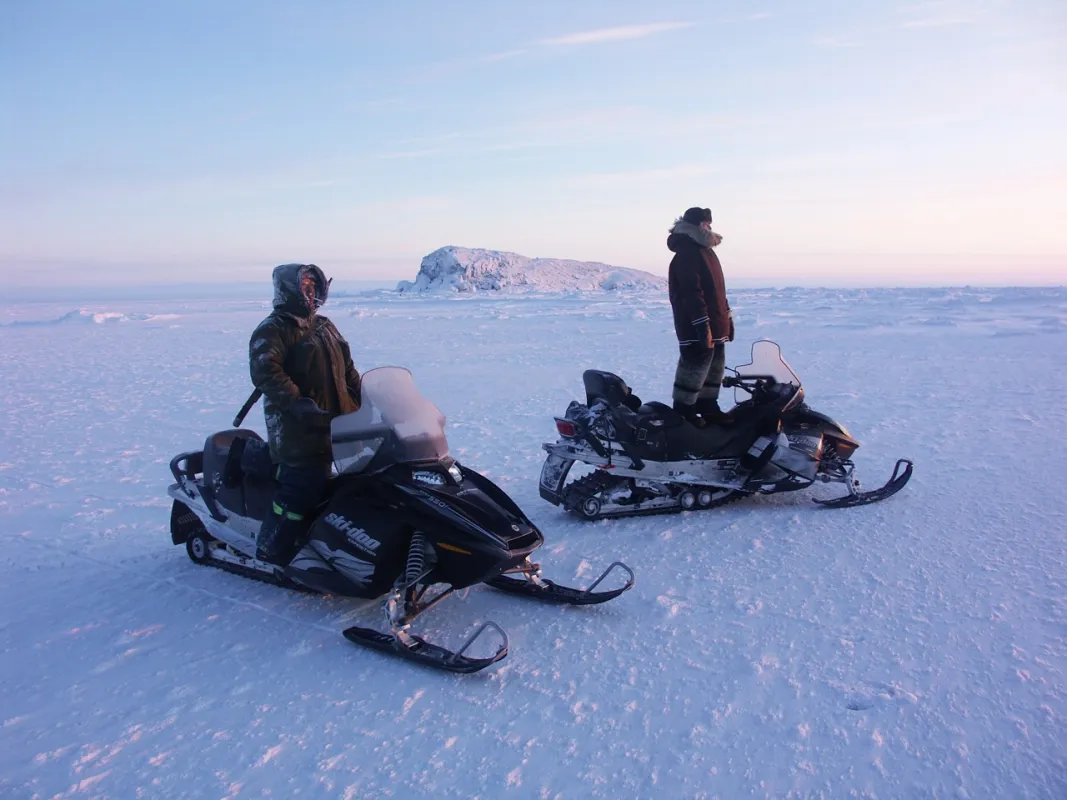By Jane Beitler
Most climate researchers venture into the field once in a while, studying glaciers in Antarctica for a month or digging snow pits in the Colorado mountains for a few weeks. But one NSIDC researcher never leaves the field—Shari Gearheard lives year-round in the Inuit community of Kangiqtugaapik (Clyde River), Nunavut, Canada, where she works with native Inuit to link their traditional knowledge of the environment with climate science. NSIDC Monthly Highlights interviewed Gearheard about her life and work in the far North.
What are your research areas?
I study how science and Inuit knowledge can work together to understand the changing Arctic environment, and work on ways to combine the knowledge of scientists and Inuit to benefit local communities and help Inuit and scientists reach their goals. I am also interested in the Inuktitut language and how the language helps to communicate and explain knowledge, especially concepts of the environment.
What is it like to live and work in the Arctic?
Clyde, the community where I live, sits on the northeast coast of Baffin Island. The landscape ranges from low rolling tundra to dramatic mountains and fjords. In fact, some of the highest, uninterrupted vertical cliffs in the world are just a short snow machine ride away in Sam Ford Fjord. People here rely on a subsistence economy and "country food." Inuit in Clyde eat seals, narwhal, Arctic char, caribou, polar bear, geese, eggs, and some traditional plants. The weather is literally arctic. Temperatures range from about negative 35 degrees Celsius [-31 degrees Fahrenheit] in the winter, though it can get much colder, to 8 degrees Celsius [46 degrees Fahrenheit] in the summer, though it can be much warmer. We have 24-hour light and 24-hour dark for several months of the year.
I love living in Clyde because of the people. I have good friends here and I learn so much every day. I am grateful to the people who work on projects with me and also help me with other aspects of living and learning here. For example I have learned how to sew clothing (especially warm parkas) and I have become a passionate dog teamer. All of my knowledge and skills around dogs are because people have been willing to share that with me. I can't put into words how grateful and fortunate I am for living in this place.
How is working in Canada's far north different than working at the NSIDC offices in Boulder, Colorado?
Working here is much different than at NSIDC. I have a small office in my house, but most of the time my work takes me into the kitchens of local hunters and Elders who partner with me on all my projects. We also work on the sea ice much of the time, travelling by snow machine and dog team. In the summer, we travel by boat and ATV. I never stop moving for long, and having the opportunity to work so much outside is really incredible, I am learning so many new skills all the time. I'm very fortunate that NSIDC supports having a researcher in the field like this. To me being here is more than "living in the field." This is my life. I have a home here, my husband, dogs, and friends are here. Living here and being part of the community helps my research, because I am able to observe and experience life and the environment all year and over many years. I am more easily able to continue to learn and practice the language, and I am learning skills that I would never learn anywhere else, like dog teaming, hunting, and how to travel the land and ice. Living here also ensures that I can design projects that come from local ideas, and cooperate with local individuals and organizations. I'm able to contribute something to the community every day and be part of the ongoing sharing and learning that happens here.
What's one thing you want people to know about your work or the people you work with?
I want people to know that there are many ways to know the world. Science and indigenous knowledge are complementary sources of information, knowledge, and evidence that can be brought together to help us to understand many environmental patterns, processes, and changes. If you know anyone who has worked outside for most of their life (a farmer, fisherman, forester, ski patrol, hunter, gardener) you know how much these people can know about the world around them. Research, more and more, is learning from and including indigenous knowledge and citizen science. I think this is a very good thing.
What are you currently researching?
I have three major projects going on at the moment: The ELOKA project provides data management and user support to facilitate the collection, preservation, exchange, and use of local observations and knowledge of the Arctic. [http://eloka-arctic.org/] The Silalirijiit project, or "Linking Inuit Knowledge and Local-Scale Environmental Modeling to Evaluate the Impacts of Changing Weather on Human Activities at Clyde River, Nunavut," links Inuit observations of the environment to quantitative climate models. The Arnait (Women) Project, or "Inuit women and subsistence: Social and Environmental Change," focuses on women's changing roles in two communities in Nunavut (Clyde River and Qikiqtarjuaq). Many research projects have looked at harvesting and economies in Inuit communities, but they almost always focus on men and on hunting. We are interested in what women's roles and concerns are in terms of mixed economies in the two communities, how women share resources and knowledge, how these have changed over time, and what practical resources women need today to have a healthy life.

